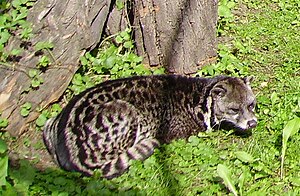Asiatic civets
| Asiatic civets | ||||||||||||
|---|---|---|---|---|---|---|---|---|---|---|---|---|

Malay civet ( Viverra tangalunga ) |
||||||||||||
| Systematics | ||||||||||||
|
||||||||||||
| Scientific name | ||||||||||||
| Viverra | ||||||||||||
| Linnaeus , 1758 |
The Asiatic civet cats ( Viverra ) are a genus of predators from the family of the stealthy cats (Viverridae). The genus includes four species.
description
Asian civets are outwardly cat-like animals, but differ in their pointed head and relatively long legs. Their fur is long and soft, with elongated hair on the top of their back forming a back crest. The basic color is gray with black spots, the size of which depends on the species. The back crest and legs are also black. The throat is provided with several black and white stripes, the tail is also ringed in black and white.
These animals reach a head body length of 59 to 95 centimeters, a tail length of 30 to 48 centimeters and a weight of 5 to 11 kilograms.
distribution and habitat
Asian civets are native to South and Southeast Asia , their range extends from India and southern China to the southern Philippines and Borneo . They inhabit a number of habitats such as forests, scrub and grasslands. They can often be found near towns and villages.
Way of life
Asiatic civets live mostly on the ground and rarely climb trees. They are exclusively nocturnal and hide during the day in dense vegetation or refer to burrows of other animals. They live solitary outside of the mating season and are territorial animals that mark their territory with the strongly smelling secretion of their perianal glands . This secretion plays a well-known role in the perfume industry as civet .
food
Civet cats are skilled hunters, and their menu includes small mammals, birds, snakes, frogs, insects, fish and crabs. But sometimes they also consume fruits and roots.
Reproduction
Once or twice a year the female gives birth to the offspring, the litter size is usually two or three young. Weaning begins after a month. Life expectancy is estimated at five to 15 years, animals in captivity can reach over 20 years.
Asian civets and humans
Asiatic civets were used to obtain civet , a secretion from their perianal glands used to create perfumes . This practice is on the decline, however, as civet is now mostly made from artificial substitutes. As animals that can also live near cities, they are widespread and are not endangered species, with the exception of the critically endangered Malabar civet.
Systematics and types
There are four types of Asiatic civet cats:
- The Indian civet cat ( Viverra zibetha ) is native to eastern India and Southeast Asia, and its range extends from Nepal to southern China and Thailand . Their fur is weakly spotted and sometimes looks marbled. In contrast to the small Indian civet cat , which is classified in its own genus ( Viverricula ), it is also known as the large Indian civet cat.
- The Malay civet , also known as the Tangalunga ( Viverra tangalunga ), lives on the Malay Peninsula , Indonesia and the southern Philippines . Their fur has small black spots. The species was naturalized on several Southeast Asian islands for the production of civets.
- The great spot civet ( Viverra megaspila ) is native to large parts of Southeast Asia. It usually has larger and more visible spots than the other species.
- The Malabar civet cat ( Viverra civettina ) lives in a small area in southwest India and is one of the most threatened mammal species. The total population is estimated at less than 250 animals, the IUCN lists the species as critically endangered.
The latter two species are compared to the others in the subgenus Moschothera . In some classifications, the Malabar civet cat is only a subspecies of the large spot civet cat.
In addition to the recent species, the genus also includes a number of extinct representatives that were not only common in Asia, but also in Europe and Africa. Viverra leakeyi from southeast Africa is considered the largest species of the genus.
literature
- Ronald M. Nowak: Walker's Mammals of the World . Johns Hopkins University Press, 1999 ISBN 0-8018-5789-9
Web links
- http://paleoitalia.org/media/u/archives/195_Sardella.pdf (predators of the Messinian of Italy, including crawling cats of the genus Viverra )